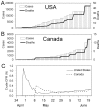Early epidemiological assessment of the virulence of emerging infectious diseases: a case study of an influenza pandemic
- PMID: 19718434
- PMCID: PMC2729920
- DOI: 10.1371/journal.pone.0006852
Early epidemiological assessment of the virulence of emerging infectious diseases: a case study of an influenza pandemic
Abstract
Background: The case fatality ratio (CFR), the ratio of deaths from an infectious disease to the number of cases, provides an assessment of virulence. Calculation of the ratio of the cumulative number of deaths to cases during the course of an epidemic tends to result in a biased CFR. The present study develops a simple method to obtain an unbiased estimate of confirmed CFR (cCFR), using only the confirmed cases as the denominator, at an early stage of epidemic, even when there have been only a few deaths.
Methodology/principal findings: Our method adjusts the biased cCFR by a factor of underestimation which is informed by the time from symptom onset to death. We first examine the approach by analyzing an outbreak of severe acute respiratory syndrome in Hong Kong (2003) with known unbiased cCFR estimate, and then investigate published epidemiological datasets of novel swine-origin influenza A (H1N1) virus infection in the USA and Canada (2009). Because observation of a few deaths alone does not permit estimating the distribution of the time from onset to death, the uncertainty is addressed by means of sensitivity analysis. The maximum likelihood estimate of the unbiased cCFR for influenza may lie in the range of 0.16-4.48% within the assumed parameter space for a factor of underestimation. The estimates for influenza suggest that the virulence is comparable to the early estimate in Mexico. Even when there have been no deaths, our model permits estimating a conservative upper bound of the cCFR.
Conclusions: Although one has to keep in mind that the cCFR for an entire population is vulnerable to its variations among sub-populations and underdiagnosis, our method is useful for assessing virulence at the early stage of an epidemic and for informing policy makers and the public.
Conflict of interest statement
Figures






References
-
- Butler D. Swine flu goes global. Nature. 2009;458:1082–1083. - PubMed
-
- Diekmann O, Heesterbeek JAP. New York: Wiley; 2000. Mathematical Epidemiology of Infectious Diseases: Model Building, Analysis and Interpretation.
-
- Nishiura H, Castillo-Chavez C, Safan M, Chowell G. Transmission potential of the new influenza A(H1N1) virus and its age-specificity in Japan. Euro Surveill. 2009;14:pii = 19227. - PubMed
Publication types
MeSH terms
LinkOut - more resources
Full Text Sources
Medical

